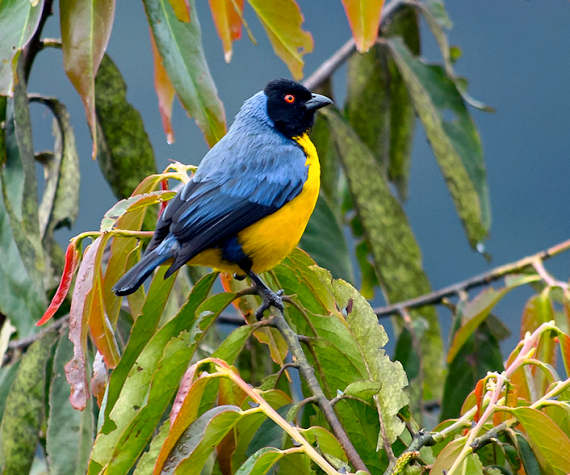The bohemian waxwing got its name for
the red waxy tips on mature feathers, and for its bohemian behavior.
These beautiful birds are very nomadic when following food sources and
their large flocking instinct leads to a communal type of protection and
sharing of food. Therefore; with their vibrant colors and sleek
appearance, bohemian waxwings are a favorite on any birder’s life list.
Bohemian Waxwings are sleek, masked birds with rare red, waxy deposits
at the tips of their secondary feathers. They’re grayish-brown with
white and yellow wing-patches and yellow terminal tail-bands. They’ve
unique crested heads, black throats, and black masks lightly lined with
white.
Their heads have a Rufous
tinges, and their under-tail coverts are Rufous. Adolescents have most
of the aforementioned field marks, but are mottled gray-brown and lack
the feather-tips. Bohemian Waxwings feather-tips seem to rise in number
and size as the bird’s age. The only bird in Washington United States
that could be confused with a Bohemian Waxwing is a Cedar Waxwing, a far
more common relative. Cedars birds are smaller and browner than
Bohemians and have yellow tinges underneath. But they have lack the
Rufous under-tail coverts and white and yellow wing markings of Bohemian
Waxwings.
Bohemian Waxwings habits
includes to breeds in open areas and edges of boreal forests, habitually
in places with sparse tree cover above brushy understory. In winter
season, they can be found in a diversity of habitats, as long as there
is fruit available. They habitually congregate in towns with abundant
plantings of fruit-bearing trees. Bohemian Waxwings are monogamous, and
both members of the pair help build the nest, which is habitually on a
horizontal branch of a spruce tree. Their nest is a loose, open cup made
of grass, twigs, and moss, lined with feathers and fine grass.
The
female incubates four to six eggs for about fourteen to fifteen days.
Normally both parents feed the young bird, which leave the nest at
fourteen to eighteen days. The young normally stay adjacent to the nest
and are fed by the parents for another few days. Moreover; family groups
may stay together through the fall. The Fruits which are rich in sugar
have deficient in other nutrients, so it must be eaten in huge
quantities. Bohemian waxwings have a big liver which supports him to
convert sugar to energy. They can metabolize ethanol formed from the
fermentation of those sugary fruits more proficiently than humans, but
May still become intoxicated, occasionally fatally. Waxwings habitually
drink water or eat snow in winter, since the sugar in their fruit diet
tends to dehydrate the birds through an osmotic effect. In the summer,
the fruits are juicier and water is less of a problem.
Bohemian
Waxwings behavior may be mixed in with other common Cedar Waxwing
flocks during the winter. They habitually perch atop trees to forage for
fruits and berries. However in summer conditions, they fly out to catch
aerial insects, but they’re primarily likes fruit-eaters, a trait that
dictates much of their behavior. Bohemian Waxwings eat almost nothing
but fruit in the winter, relying on the berries of mountain ash,
juniper, holly, and others. They also forage on fruit crops and
ornamental plantings. Bohemian Waxwings are susceptible to alcohol
intoxication, and even death, from eating fermented fruit. Like most
songbirds, they feed insects to their young at first, but switch to
feeding the young berries within a few days.
The
bird’s migration is nomadic and irruptive species roams in search of
food sources, rather than undertaking a typical migration. However; food
availability seems to be a more imperative predictor of winter presence
than temperature or latitude. Populations fluctuate considerably from
year to year, but Christmas Bird Count Data reveals a slightly declining
long-term trend. Maximum Bohemian Waxwings in Washington are northern
breeders that come down into Washington in winter. In many years they’re
fairly common in winter in northeastern Washington Ferry, Douglas,
Okanogan, Stevens, and Pend Oreille Counties, particularly in cities and
towns where they feed on fruit trees. In few years they’d extend
farther west into the Columbia Basin, and can rarely be seen west of the
Cascades. Bohemian Waxwings are erratic breeders in Washington in the
North Cascades at Hart's Pass and Holman Pass.






























































